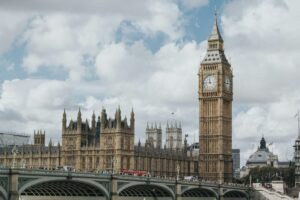Tax receipt data from HM Revenue & Customs due tomorrow will probably confirm the surging trend in the Treasury’s take from Inheritance Tax. But April’s data aside, we already know that in the decade between the tax year commencing April 2013 and that ending in March 2023, revenues from IHT soared by 108% in nominal terms.[1]
Even taking into account the increase in the consumer prices index during that period of 31.%, that is a real increase of 77% in the amount of tax levied on estates as they are passed on at death.[2]
Ian Dyall, Head of Estate Planning at wealth manager Evelyn Partners, says this is one factor behind the unpopularity of IHT across most income brackets: “As the £325,000 IHT threshold called the nil-rate band has been frozen since April 2009, many more estates – in most cases of modest size in real terms – are being drawn into liability.”
IHT raised a record £7.1billion in the latest financial year – £1billion or 17% more than in the previous year.
Dyall adds: “Beneficiaries not usually considered well-off are facing tax bills, and this can be especially problematic if a property comprises the majority of the estate, leaving few liquid assets to foot the bill.”
There are other factors: in most cases tax has already been paid on the assets and taxing them as they are passed on after death is seen as committing the sin of double taxation, at a substantial rate of 40%. Finally, there is a feeling among many taxpayers that money and possessions are family assets and so transferring them from one generation to another should not be a taxable event full stop. Arguments of social and generational equity can be ranged against this.
Dyall observes that there is now a further aggravation: “The increasing tax burden from frozen and reduced income tax thresholds – as well as the shrinking capital gains tax allowance – will make many households feel squeezed in the coming years, particularly against the background of a cost of living crisis.[3] As income tax is very difficult to seek protection against, families will naturally try to make sure that they reduce or minimise tax liabilities in other respects.
“And one of these will be the transfer of wealth. Those who feel they have paid enough tax on their earnings or assets will naturally try to take advantage of any allowances and strategies available which mean that when they die their beneficiaries will not be landed with unnecessary tax bills.”
There are a number of well-known ways of reducing an IHT liability including gifting during lifetime, drafting your will in a way that exemptions are maximised, the use of trusts, and investing in assets benefitting from business relief.
“However, there are a handful of lesser-known tactics that can be equally effective,” says Dyall. He outlines three areas where those planning an efficient transfer of wealth could act shrewdly.
1. Downsizing relief
On top of the £325,000 nil rate band IHT exemption that everyone is entitled to, there is an additional £175,000 residential nil-rate band (RNRB) exemption if you pass your main home on to your direct descendants at your death. This includes your children and grandchildren, including a stepchild or foster child.
As unused nil-rate band allowances are passed on to the surviving spouse at the death of the first spouse, this creates the possibility that a surviving parent could pass on £1million with IHT exemption (two x £325,00 NRB plus two x £175,000 RNRB). This is as long as your property is worth at least £350,000 at death.
However, the home does not necessarily have to be in possession at death for its value to be considered against RNRB relief. If you owned your home after 7 July 2015 and sold it in order to downsize or move into a care home, your executors might be able to claim downsizing relief (it won’t be applied automatically).
The assets that the relief is being claimed for do not have to be shown as directly accruing from the sale of the home, but you must leave sufficient money to children or grandchildren to cover the amount being claimed. And the property must have been your home at some point after 7 July 2015 and sold before you died.
Finally, note that the RNRB starts to disappear for large estates. When the £2million taper threshold is exceeded, the RNRB is reduced by £1 for every £2 of value by which an estate exceeds the taper threshold. Tapering can reduce the RNRB to zero: there will be no RNRB if the estate exceeds £2.35m or £2.70m if it includes 100% of brought forward allowance. This RNRB limit applies equally to downsizing relief.
2. Ongoing gifts out of surplus income
Many older savers like to give ongoing regular amounts to loved ones. These could be payments for young relatives into a Junior ISA, pension or trust, or even to adult children to help with their finances. But not everyone appreciates that these payments can be IHT-efficient, as long as they meet certain rules.
While the number of estates faced with an IHT charge hit a 20-year high of 41,000 in 2022, up from 33,000 the year before, in the last year just 430 families took advantage of this exemption – but they made a combined saving of a substantial £67m.[4]
Surplus income is what remains after all of your outgoings have been paid: funds left over which are surplus to needs and have no bearing on your standard of living. Your income includes earnings from employment and pensions, but it can also include interest, dividends and rental income. But some regular payments which savers might think of as ‘income’ are not counted.
Two of the most common examples of this are regular withdrawals taken from a life assurance bond and if you have a purchased life annuity (i.e. it was not purchased with pension funds and was bought through other sources). Only part of the annuity will be considered as income and the remainder will be a return of your invested capital, as will all the withdrawals made from life assurance bonds.
This gifting can be as simple as setting up a regular standing order directly into the recipient’s bank account. Alternatively, you might want to set up some sort of policy for the recipient, such as a life insurance or pension plan, and you could pay the regular premiums out of your surplus income. Parents or grandparents can pay into a JISA, an early-years pension or a trust to house accumulated regular gifts for their offspring.
The ‘normal expenditure out of income’ exemption will apply even if you die within seven years of the last gift, as long as three key rules are met:
· The gifts must be made out of your income
· They form a part of your ‘normal expenditure’ and are paid out on a regular basis
· The payments should not have any impact on your own standard of living
Then the gifts will be exempt from IHT and neither the recipients nor the estate will pay tax on them.
Normal expenditure can be a grey and difficult area, and a possible source of dispute with HMRC when executors come to deal an IHT liability. The best policy for a donor is to set out their intentions around regular gifting and to keep clear paperwork recording the gifts, alongside their overall income and expenditure. The last page of the IHT403 form, available online, will show you the details you need to keep.
3. Defined contribution pensions
Many savers now know about the tax benefits of pension saving, in terms of pension tax relief, but fewer are aware of their potential in reducing the IHT liability of their estate. Put simply, defined contribution pension pots are not subject to IHT as they are not counted as part of your estate.
If you have used part of your pot to buy an annuity that will be counted as removed from the pension – just as any tax-free lump sum will be – although the annuity itself might have a death payout if you chose such a product. It is funds remaining in either a DC pension pot or in drawdown that could be useful in passing on wealth tax-efficiently.
If you die before age 75, whoever inherits your savings pays no IHT and can also draw on the money with no income tax to pay. If you die after 75, your heirs still pay no IHT, but there will be income tax charges on withdrawals at their marginal rate. (Savers must make sure that the details on their pension policy where they name the person(s) who will benefit in case of death are correct and up to date.)
All this has implications for estate planning. You might for instance choose to draw on other savings and assets – which would count as part of your estate – to fund your retirement, leaving your pension savings intact as far as possible. You might also choose to funnel funds from elsewhere into your pension, with the IHT efficiency in mind. This comes with the added advantage that the pension will be accessible right up until death, which allays fears that can arise from giving away wealth during lifetime.
The possibilities for this strategy have on the face of it become greater with the scrapping of the Lifetime Allowance charge in the Chancellor’s Spring Budget. This means there is no longer a limit (previously £1.076million) over which a pension fund could be subject to excess tax charges on access.
However, the IHT-beneficial status of DC pots might not last forever, as some see it as an anomaly, and likewise the scrapping of the LTA could be reversed by a future government. If either of these changes come to pass, it would be nice to think that decisions that savers make now in the light of current policy would not be penalised – but this is not impossible.
Savers who do decide to build up a substantial DC pot, taking advantage of generous tax reliefs (which are also not guaranteed to last forever) might reflect that it is probably no bad thing whatever happens.














